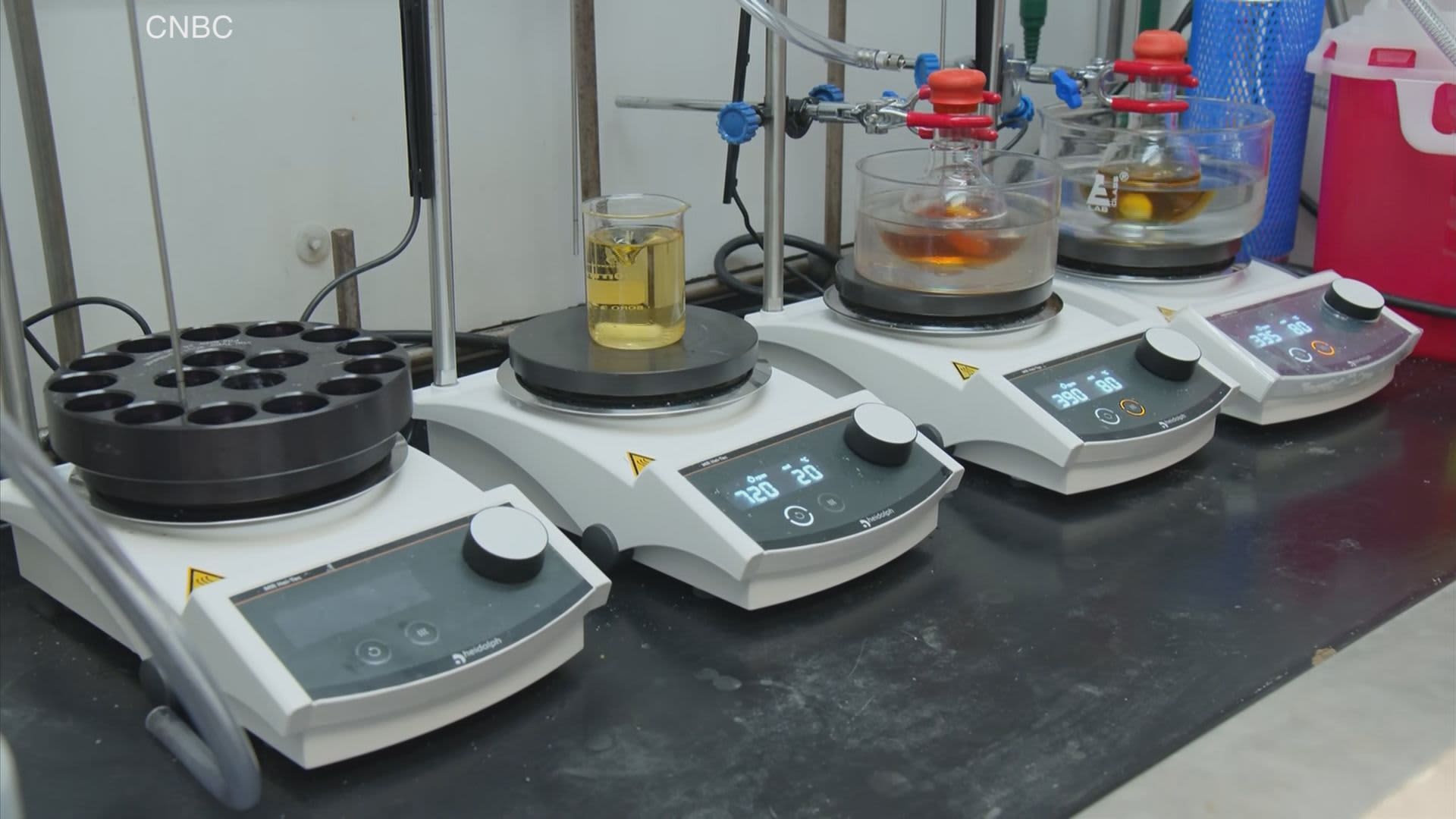Chemistry, Not Electronics, Will Help Solar Reach Its Full Potential

A material that has been heralded as the key to producing more efficient next-generation solar panels could soon be ready for mass production, thanks to a new method developed by researchers at the University of Surrey.
The Surrey team found that fusing perovskite materials with an element called ferrocene dramatically increases the efficiency of perovskite-based solar panels. The team found that this focus on the chemistry of solar panels, rather than other approaches that looked at mechanical and electrical components, produced the intended breakthrough.
“Our research scales these perovskite cells to a minute level, focusing on the chemical compounds and their specific problems. For example, normal practice is to coat, or ‘dope’, cells in lithium, but lithium absorbs water, increasing energy deficiency over time,” said Thomas Webb, postgraduate research student and project lead from the University of Surrey. “We discovered an element within organometallic chemistry called Ferrocene that significantly improves efficiency and stabilises the drop in energy that all solar panels have over time. Not to mention it is cheap to produce and solves the water absorption problem.”
Perovskite materials are widely considered to be the successor to silicon because they are lightweight and far cheaper to produce. However, the promise of perovskite has yet to be realised because of the difficulty of replicating lab results in mass production.
“Silicon cells are efficient but costly to produce; perovskite materials are without a doubt the next generation of photovoltaic technologies,” explains Dr. Wei Zhang, the primary supervisor of the research and project lead from the University of Surrey. “There is still a long way to go to ensure these can be implemented on a mass scale, but with these results, we are a generous step closer to making this a reality.”
Professor Stephen Sweeney, the co-supervisor of the research from the University of Surrey, added, “This is a key development to advance this important new material system at a time when dependable renewable energy sources are of critical global importance. This is also a very satisfying example of how interdisciplinary research and complementary expertise across the partner universities has led to a high impact outcome.”
The project has been produced in collaboration with Imperial College London, the University of Nottingham, London Southbank University, University College London, and Fluxim AG. The research was published in Advanced Energy Materials.
The University of Surrey is a leading research institution that focuses on sustainability to deliver impacts that benefit society and help deal with the many challenges of climate change. Surrey is also committed to improving its own resource efficiency on its campuses in Guildford and aspires to be a sector leader. It has set a commitment to be carbon neutral by 2030. In April, it was ranked 55th in the world by the Times Higher Education (THE) University Impact Rankings which assesses more than 1,400 universities’ performance against the United Nations’ Sustainable Development Goals (SDGs).
Figure 1
Open in figure viewer
PowerPoint
a) Structure of ferrocene sandwich complex. b) Device architecture and location of ferrocene in preparing perovskite solar cells. c) Structure of spiro-OMeTAD, (red) C14H14NO2+ fragment tracked in SIMS measurements. d) OrbiSIMS depth profiles of control perovskite/spiro-OMeTAD sample after 200 h in N2, Pb2+ signal corresponding to perovskite normalized to C14H14NO2+ attributed to the methoxyphenol amine branches of spiro-OMeTAD. e) OrbiSIMS depth profiles of ferrocene treated perovskite/ferrocene/spiro- OMeTAD sample after 200 h in N2, additional Fe+ is attributed to the incorporation of ferrocene. f) 3D reconstructed secondary ion images of Li+ (left, blue) and C14H14NO2+ fragment of spiro-OMeTAD (right, red) in films prepared without ferrocene, g) 3D reconstructed secondary ion images of Li+ (left, blue) and C14H14NO2+ fragment of spiro-OMeTAD (right, red) in films prepared with ferrocene, identical solutions of doped spiro-OMeTAD were used for both OrbiSIMS measurements, variations in the absolute intensity of counts are attributed to matrix effects.
” data-image-caption data-medium-file=”https://cleantechnica.com/files/2022/06/Screenshot-420-1-400×376.png” data-large-file=”https://cleantechnica.com/files/2022/06/Screenshot-420-1-800×751.png” loading=”lazy” class=”wp-image-269939 size-large” src=”https://cleantechnica.com/files/2022/06/Screenshot-420-1-800×751.png” alt width=”800″ height=”751″ srcset=”https://cleantechnica.com/files/2022/06/Screenshot-420-1-800×751.png 800w, https://cleantechnica.com/files/2022/06/Screenshot-420-1-400×376.png 400w, https://cleantechnica.com/files/2022/06/Screenshot-420-1-768×721.png 768w, https://cleantechnica.com/files/2022/06/Screenshot-420-1.png 915w” sizes=”(max-width: 800px) 100vw, 800px”>
Figure 1 Open in figure viewer PowerPoint a) Structure of ferrocene sandwich complex. b) Device architecture and location of ferrocene in preparing perovskite solar cells. c) Structure of spiro-OMeTAD, (red) C14H14NO2+ fragment tracked in SIMS measurements. d) OrbiSIMS depth profiles of control perovskite/spiro-OMeTAD sample after 200 h in N2, Pb2+ signal corresponding to perovskite normalized to C14H14NO2+ attributed to the methoxyphenol amine branches of spiro-OMeTAD. e) OrbiSIMS depth profiles of ferrocene treated perovskite/ferrocene/spiro- OMeTAD sample after 200 h in N2, additional Fe+ is attributed to the incorporation of ferrocene. f) 3D reconstructed secondary ion images of Li+ (left, blue) and C14H14NO2+ fragment of spiro-OMeTAD (right, red) in films prepared without ferrocene, g) 3D reconstructed secondary ion images of Li+ (left, blue) and C14H14NO2+ fragment of spiro-OMeTAD (right, red) in films prepared with ferrocene, identical solutions of doped spiro-OMeTAD were used for both OrbiSIMS measurements, variations in the absolute intensity of counts are attributed to matrix effects. Image: A Multifaceted Ferrocene Interlayer for Highly Stable and Efficient Lithium Doped Spiro-OMeTAD-based Perovskite Solar Cells
Courtesy of The University of Surrey
Check out our brand new E-Bike Guide. If you’re curious about electric bikes, this is the best place to start your e-mobility journey!
Appreciate CleanTechnica’s originality and cleantech news coverage? Consider becoming a CleanTechnica Member, Supporter, Technician, or Ambassador — or a patron on Patreon.
Advertisement
 This post has been syndicated from a third-party source. View the original article here.
This post has been syndicated from a third-party source. View the original article here.





